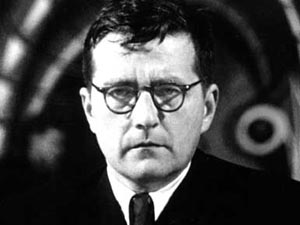Dmitriĭ Shostakovich (1906-1975)
Born September 25, 1906 in St. Petersburg.
Cello Concerto No. 1 in E Flat, Opus 107
Composed 1959
First Performance: Leningrad Conservatory October 9, 1959 Rostropovich, Yevgeny Mravinsky
Instrumentation: 2 flutes, piccolo, 2 oboes, 2 clarinets, bassoon, contrabassoon, horn in F, timpani, Celesta and strings.
Prokofiev’s Cello Concerto (Op. 58) was infrequently played after its premiere, until Prokofiev heard Rostropovich play it at a 1947 concert. He rewrote the concerto with advice from Rostropovich to create the Symphony-Concerto (Op. 125). To a great extent Shostakovich’s First ‘Cello Concerto is based on Prokofiev’s Symphony-Concerto. There are many connections between the two pieces beside Rostropovich’s involvement. After a performance of the Prokofiev, Shostakovich remarked “Slavka, how that one-legged guy thumped his drum [timpani]! It called a halt to everything with that final blow.” The fourth movement of Shostakovich’s concerto ends with seven thumps on the timpani – although there is no requirement for the player to be one- legged.
The concerto contains a great many quotations notably the Trepak from Mussorgsky’s Songs and Dances of Death and Stalin’s favorite folk song Suliko. In his cantata Rayok Shostakovich used Suliko in its entirety as a sarcastic tribute to the “Great Leader and Friend of Children”. The quotation is not especially obvious. During a rehearsal Shostakovich asked Rostropovich “Slava, have you noticed?” [he didn’t] then laughed and sang “Suliko, Suliko, where is my Suliko.”
Example 1. Georgian folk song Suliko

Example 2. Suliko quotation in fourth movement

A few years after the concerto Shostakovich orchestrated the Songs and Dances of Death, modifying the bass voice to soprano for Rostropovich’s wife Galina Vishnevskaya. The First ‘Cello concerto is in turn, quoted prominently in his Eighth String Quartet.
The movements are as follows:
I Allegretto
II Moderato
III Cadenza – Attacca
IV Allegro con moto
The work begins with what Shostakovich described as “an ironic march” played by the solo ‘cello and woodwinds. This theme is related to his score for the 1948 film The Young Guard, which illustrates a group of Soviet soldiers being marched to their deaths.
The four note motto heard right at the beginning is developed throughout the work. Sometimes the rhythm is different, sometimes the intervals are modified but it is always recognizable as this initial statement. In a later hearing the motto is turned inside out to show that it is derived from the composer’s initials. In the German orthography for the pitch names E flat is “s” and B natural is “h”. There are a great many later works by Shostakovich that use this motif, notably his Tenth Symphony and the autobiographical Eighth String Quartet.
The accompanying interjection wonderfully scored from the sepulchral rumblings of the low contrabassoon right up to the high woodwinds contains a rhythmic motif that is also heard throughout.
A second theme emerges over a rearranged signature motif.
A third theme recalls the lullaby sung by Death to a sick child in the first song from Mussorgsky’s Songs and Dances of Death.
The second, third and fourth movements are played without a break between them. The second movement begins with a long introspective theme passed between the cello and the orchestra.
Gradually the music builds to a climax which is resolved by a quiet horn solo. The movement ends with the cello playing the initial melody with harmonics with the celesta sounding eerily over the strings.
The long cadenza is a movement in itself. It begins by developing the material from the second movement, and ends with the work’s opening theme which leads immediately to the finale.
The finale begins the Suliko quotation. The material from the first movement reappears along with a second quotation from the Songs and Dances of Death. This time it is the Trepak where a drunken peasant is seduced by death in a whirling snowstorm. The cello portrays this by a long series of cascading thirty second notes accompanied by the motto that begins the work. The sardonic motto from the first movement reappears along with the original woodwind response traded between the soloist and orchestra. The timpani abruptly end this duologue with seven decisive blows.
Resources
[amazon template=iframe image&asin=B001380NCS][amazon template=iframe image&asin=B000G7PNL8][amazon template=iframe image&asin=B000001GIT][amazon template=iframe image&asin=B00005A8EJ][amazon template=iframe image&asin=B000076GYI][amazon template=iframe image&asin=B00002S5EU]
[amazon template=iframe image&asin=B00PIYU904][amazon template=iframe image&asin=B008526XEM]





